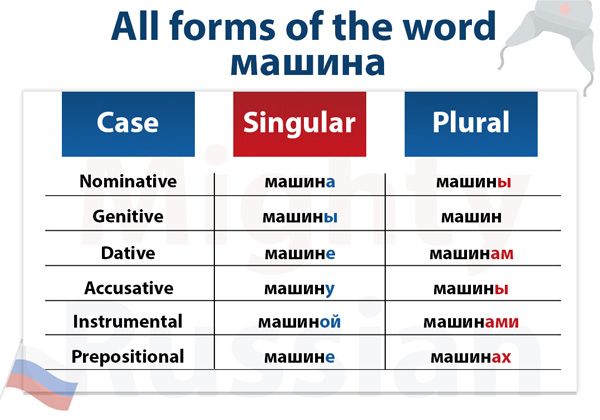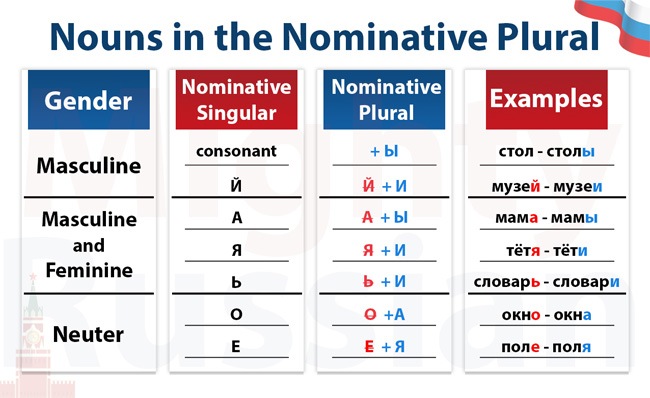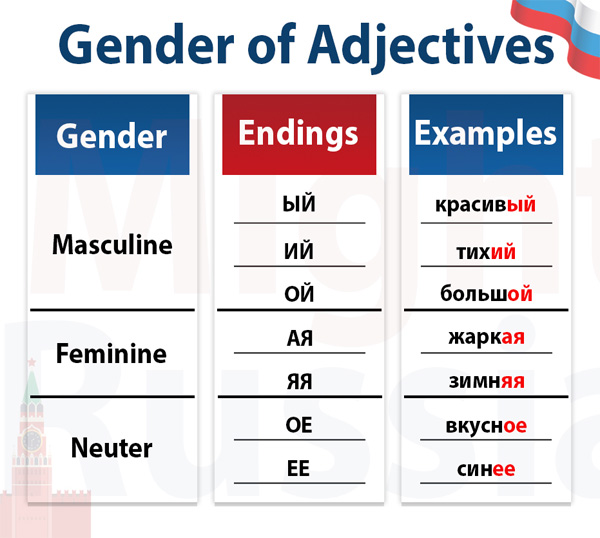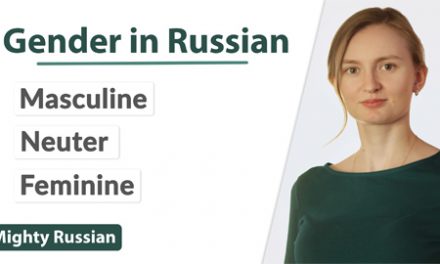The Nominative Case in Russian
The Nominative Case is the easiest case in Russian and should be the first one to learn.
Nouns and adjectives in the Nominative Case are the ones you see in the dictionary.
In other words, the Nominative Case is the “original” form of nouns and adjectives.
For example:
девочка (girl)
хороший (good)
деньги (money)
In this lesson, we will cover everything you need to know about the Nominative Case and the concept of case in general.
To make things easier, I will divide this lesson into 4 parts:
2) The main uses of the Nominative Case;
3) Plural nouns in the Nominative Case;
4) Adjectives in the Nominative Case.
All the above titles have links. If there is any specific subject you would like to learn first, you can click on it and go straight to that part of the lesson.
What are cases in Russian?
“Case” is normally a new concept for native English speakers but it’s very simple to understand.
Think about cases as different forms of the same word.
Each of these forms will be used in specific situations.
In English, there are no cases. So, the words “car” and “house”, for example, have only one form in the singular and one form in the plural: “car – cars” and “house – houses”.
In Russian, however, there are 6 cases:
1) Nominative
2) Genitive
3) Dative
4) Accusative
5) Instrumental
6) Prepositional
That basically means that each noun has 6 forms in the singular and 6 forms in the plural.
Let’s take the word “машина / car” as an example:
As you can see, because of the 6 cases, the word “машина” has a total of 12 forms.
Each of these forms is used in specific situations.
Memorizing all the endings of every Russian noun is usually scary for learners, but you don’t have to worry about this.
At Mighty Russian, you will find complete lessons about all the Russian cases.
When we explain a case at Mighty Russian, we always group all the rules into a few patterns, which makes the memorization process much easier.
After this lesson, you will already know how to use the Nominative Case.
The main uses of the Nominative Case
The Nominative Case is the dictionary form of a noun.
So, whenever you look for a new word in places like Google Translate, the result will be in the Nominative Case.
All the situations in which we use the Nominative Case are very basic. Let’s take a look at the most common ones.
The Nominative Case to indicate the subject of a sentence
In Russian, the subject of a sentence is always in the Nominative Case.
For example:
Девочка читает книгу (The girl is reading a book)
Собака спит (The dog is sleeping)
Mашина красная (The car is red)
Note that articles don’t exist in Russian.
That means that, in Russian, there are no equivalents to the English words “the“, “a” and “an“.
The Nominative Case after the word “это”
“Это” means “this”, “that”, “these” and “those”.
For example:
Это книга (This is a book)
Это мои друзья (These are my firends)
Note that, this time, we don’t have any equivalent to the verb “is”.
That’s because, in Russian, the verb “to be” is normally omitted in the present tense.
The Nominative Case after the word “вот”
“Вот” means “here is” or “here are”.
For example:
Вот твой ключ (Here is your key)
Вот деньги (Here is the money)
Very simple, right?
Now let’s take a look at the plural.
Plural Nouns in the Nominative Case
Forming the plural in Russian is very simple, but there are a few rules you will have to memorize.
To make things easier, let’s divide all the rules into 5 patterns.
You will notice that the ending of a noun depends on its gender.
The concept of gender is often new for native English speakers, so if you find it confusing, you can check out our complete lesson about gender clicking here.
1) Adding “Ы” to masculine nouns that end in a consonant:
стол – столы (table)
кот – коты (cat)
фильм – фильмы (film)
студент – студенты (student)
Some masculine nouns take “А” instead of “Ы”.
Here are the most common of them:
год – года (year)
город – города (city)
поезд – поезда (train)
вечер – вечера (evening)
Try not to worry about these exceptions. You will naturally learn them as you practice your Russian.
2) When nouns end in “А”, replace “А” with “Ы”:
машина – машины (car)
мама – мамы (mother)
папа – папы (father)
мужчина – мужчины (man)
There is a very common spelling rule in Russian that you have to apply here.
After the consonants “К”, “Г”, “Ш”, “Щ”, “Ч”, “Ж” and “Х”, you can’t write “Ы”. Instead, you have to write “И”:
книга – книги (book)
девушка – девушки (girl)
There is a reason why this spelling rule exists.
If you try to pronounce any of these consonants with the vowel “Ы”, you will notice it’s much more uncomfortable than with the vowel “И”.
Compare, for example, “ГЫ” or “ЧЫ” and “ГИ” or “ЧИ”.
“ГИ” and “ЧИ” are much easier to pronounce, aren’t they?
So you just have to practice your Russian a little and you will easily be able to tell when you should use “Ы” and when you should use “И”.
3) When masculine nouns end in “Й” or “Ь” and feminine nouns in “Я” or “Ь”, replace the last letter with “И”:
словарь – словари (dictionary)
музей – музеи (museum)
тетрадь – тетради (notebook)
ночь – ночи (night)
песня – песни (song)
тётя – тёти (aunt)
4) When neuter nouns end in “О”, replace “О” with “А”:
слово – слова (word)
окно – окна (window)
письмо – письма (letter)
5) When neuter nouns end in “Е”, replace “Е” with “Я”:
поле – поля (field)
море – моря (sea)
платье – платья (dress)
Here is a table with all the rules. Feel free to take a screenshot of it and even print it out, so you can you it later in your studies.
Now, keep in mind that, as in any other language, there are exceptions in Russian.
Here are the most common of them:
Exceptions may seem hard to memorize, but try not to focus too much on them.
The most important thing is to practice your Russian skills on a regular basis and you will memorize all the rules, patterns and exceptions naturally.
Adjectives in the Nominative Case
In Russian, each adjective has 4 forms: masculine, feminine, neuter and plural.
For example:
новый год (a new year)
новая куртка (a new jacket)
новое блюдо (a new dish)
новые дома (new houses)
As you can see, the adjective “новый / new” changes depending on the gender of the noun it describes (in a dictionary, the adjective is normally listed in the masculine form).
Here are the endings that adjectives have in each gender:
Let’s take a look at each of these endings in more detail.
Adjectives used with masculine nouns:
01) The ending “ЫЙ” is the most common one.
For example:
новый студент (a new student)
белый снег (white snow)
тёплый день (a warm day)
02) The ending “ИЙ“ is normally used when the last consonant of the adjective is “Г”, “К”, “Х”, “Ж”, “Ч”, “Ш” or “Щ”.
For example:
русский город (a Russian city)
горячий шоколад (hot chocolate)
хороший игрок (a good player)
03) And the least common ending is “ОЙ”.
For example:
дорогой подарок (an expensive gift)
молодой человек (a young person)
плохой день (a bad day)
Adjectives used with feminine nouns:
01) The ending “АЯ” is the most common one.
For example:
хорошая сумка (a good bag)
новая машина (a new car)
старая куртка (an old jacket)
02) Sometimes, the ending is “ЯЯ”.
For example:
летняя одежда (summer clothes)
утренняя программа (a morning program)
синяя кружка (a blue mug)
Adjectives used with neuter nouns:
01) The most common ending is “ОЕ”.
For example:
новое платье (a new dress)
вкусное яблоко (a tasty apple)
красивое имя (a beautiful name)
02) Some adjectives end in “ЕЕ”.
For example:
летнее время (summer time)
горячее блюдо (a hot dish)
хорошее платье (a good dress)
Adjectives used with plural nouns:
When it comes to the plural, gender is no longer relevant. All adjectives have either the ending “ЫЕ” or “ИЕ“.
1) The most common plural ending is “ЫЕ”.
For example:
новые дома (new houses)
старые письма (old letters)
красивые девушки (beautiful girls)
2) Sometimes, the ending is “ИЕ”.
For example:
хорошие ученики (good students)
русские песни (Russian songs)
сладкие яблоки (sweet apples)
And those were all the endings that adjectives can have.
Now you know everything about the Nominative Case!
A good way to continue improving your Russian is to learn another case.
Studying the Genitive Case would be an excellent choice. It’s a bit more complicated than the Nominative Case, but it is very useful and common in Russian.
You can check out our complete lesson about the Genitive Case clicking here.
I hope everything in this lesson was clear, but if you have any questions, just leave them in the comment section below.
I will be very happy to help you!
















Первый огромное спасибо за помощь и тоже я тебе влюблен. Ты восхетиталини и хорошо барышня.
Я выучу России бистро. 👌